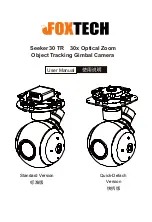
Rev 3.0/10-06
QUADRA-TILT ROTATOR • DC-VOLTAGE
Page 15
T
O
R
OTATE THE
L
OAD
E
DGEWISE
WARNING: Make sure load is positioned correctly on lifter; unbalanced loads
may rotate unexpectedly.
Remember that the load is longer in its diagonal dimensions
than in its side dimensions. Make sure there is sufficient
clearance for the load to rotate without contacting the
operator or any nearby objects. Maintain a firm grip on the
control handle to keep the load under control at all times.
Pull the rotation release lever to disengage the rotation
latch, and rotate the load to the desired position.
8
To stop
the load’s motion automatically at each quarter turn, simply
let go of the rotation release lever immediately before the
end of the turn, so that the rotation latch engages at the
next stop. Whenever rotation is not required, keep the
rotation latch engaged, to prevent accidental damage to the
load and possible injury to the operator.
T
O
T
ILT THE
L
OAD
WARNING: Always keep hands and fingers away from bars of tilt linkage.
Remember that the load requires more vertical space when tilted to the
upright position, as well as more horizontal space when tilted to the flat
position. Make sure there is sufficient clearance for the load to tilt
without contacting the operator or any nearby objects. If the lifter is
equipped with optional tilt locks, also make sure they are disengaged
prior to tilting the load (see T
O
L
IFT AND
M
OVE THE
L
OAD
: Engaging or
Disengaging Optional Tilt Locks preceding). Then lift upward or press
downward on the control handle to tilt the load as desired. Since the tilt
linkage is designed to automatically maintain the load in either the
upright or the flat position, the load force on the control handle changes direction during the tilt.
If load size permits, maintain control with the handle throughout the tilt. For loads with
overhang, it may be necessary to release the control handle as the load approaches the flat
position. If so, keep the load under control using hand cups or other appropriate means.
8
If the load's center of gravity is not centered on the pad frame, it may be necessary to relieve pressure on the rotation latch by
applying force to the pad frame in the appropriate direction of rotation.










































